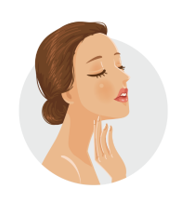Phthalates- Source, Side Effects And Avoidance Measures
September 2, 2021 2025-04-17 10:08Phthalates- Source, Side Effects And Avoidance Measures
As an Amazon associate, Dermatocare earns from valid purchase made by clicking on the affiliate links in this blog.
Phthalates- Source, Side Effects And Avoidance Measures
Phthalates is the name given to a group of compounds that has numerous side effects and should be avoided strictly by everyone. This article provides scientifically researched details (by searching journals) about sources, side effects and avoidance measures for Phthalates.
What are Phthalates?
Phthalates are group of chemicals found in:
- Personal care products especially perfumed skincare products, nail cosmetics, perfumes and shampoos, etc.
- Household exposure items like raincoats, detergents, household furnishings, plastic bags, garden hoses, flooring , wallpapers, food packing, children’s toys, cleaning material, insecticides etc.
- Hospital items like medical devices, pharmaceuticals, nutritional supplement and vinyl gloves.
- Industrial items like solvents, fixatives, adhesives, varnishes, coatings, automotive plastics, building materials, etc.
Typically, more flexible is the plastic, higher the amount of phthalates in the product. Because phthalates are not chemically bound to the plastics to which they are added, they are easily released into the environment.
How are we exposed to Phthalates?
Phthalates are not covalently bound and are easily released into the environment from its source. We are exposed to Phthalates in the following manner:
- Ingestion from phthalates in food that comes from tubing, conveyors, and gloves used during manufacturing of lids, food packing films, printing ink on food wrappers, coating of cookware etc. Food with high fat content is more likely to be contaminated due to affinity of phthalates for fats. Thus, processed dairy products, vegetables, fruits, meats, etc. contain high phthalate content.
- Inhalation from PVC flooring, wallpaper, synthetic beddings etc.
- Typically through skincare and personal care products.
- The worst source of exposure is prenatal exposure in the womb of mother as it can lead to mental and reproductive problems in the baby.
A study showed that biomarker of phthalates is present in 98% of the US population, meaning the exposure is ubiquitous because of widespread use of phthalates.
What are the harmful effects of Phthalates?
Phthalates are endocrine disruptors. Here I am listing its side effects along with some scientific evidence:
- Male Reproductive Tract Abnormalities: The exposure of Phthalates in the womb of mother has been associated with abnormalities in reproductive tract, especially decreased Ano-genital distance. Phthalates appear to cause more damage to male reproduction when the exposure occurs during male fetal development.
- Infertility in Males: Continuous exposure over lifetime has shown association of Phthalates with sperm motility and concentration, thus might be one of the contributing factors increasing cases of infertility in Males.
- Early breast development: One study has shown association between Phthalates and pre-pubertal breast development in girls.
- Testicular cancer: Studies have shown association between occupational exposure to PVC plastic (contains Phthalates) and testicular cancer.
- Complicated Pregnancies: Phthalates levels were found to be higher in pregnant females with complications when compared to those with normal pregnancy.
- Preterm birth: Pregnant women with high Phthalates levels have more chances of preterm birth.
- Endometriosis: Phthalates are associated with increased chances of Endometriosis in females.
- Obesity: Phthalates have been shown to be associated with high BMI and waist circumference.
- Respiratory problems: PVC plastic flooring, wall papers and synthetic beddings results in increase inhalation of Phthalates. Breathing indoor air with increased phthalates is associated with lung problems like asthma, respiratory obstruction, wheeze etc. shown in various studies.
- Neurodevelopmental and behavioral problems in kids: High exposure to phthalates in the womb of mother was associated with increased chanced of inattention (ADHD), rule breaking and aggressive behavior, headache, stomachache and muscular tension more so in boys than girls.
How to avoid Phthalates?
Phthalates exposure is so ubiquitous, that total avoidance is difficult. However some implementable measures include:
- Prefer wood or stone to PVC flooring and wallpapers.
- Prefer cotton to the synthetic bedding material for pillows, sheets and mattress.
- Prefer fresh and homemade milk products to packed or processed dairy products.
- Prefer fresh meat over processed and packed meat.
- Prefe r fresh fruits and vegetables over processed and packed fruit and veggies and even juices.
- Prefer glass container over plastic or tetra-packs for packing food.
- Avoid food wrapped in plastic sheets.
- Avoid frozen food.
- Avoid enteric-coated tablets unless, it is prescribed by your doctor for specific reasons. Enteric coated tablets are coated with multiple chemicals so that the drug is released into the small or large intestine to increase the efficacy. However only doctor should decide the need of such formulations. Mesalamine, didanosine, omeprazole, and theophylline are available as enteric coated tablets.
- Prefer Phthalate free skin care products: Unfortunately, phthalates might be present in personal care products, even if it is not labeled as a contaminant. The best way to avoid phthalate is to use fragrance free products and look for words “phthalates free” on the label. A report from EWG in US states that Phthalates was found in:
- 71 percent of all cosmetics tested, including deodorant, hair mousse, hair spray, and hand and body lotions;
- in 100 percent of all fragrances.
- 86 percent of all hair gels
- 67 percent of all nail polishes tested.
ROUTINE FINDER
Get free dermatologist-recommended regime by choosing your skin or concerns.

FACE

HAIRS

CHILD

BODY




